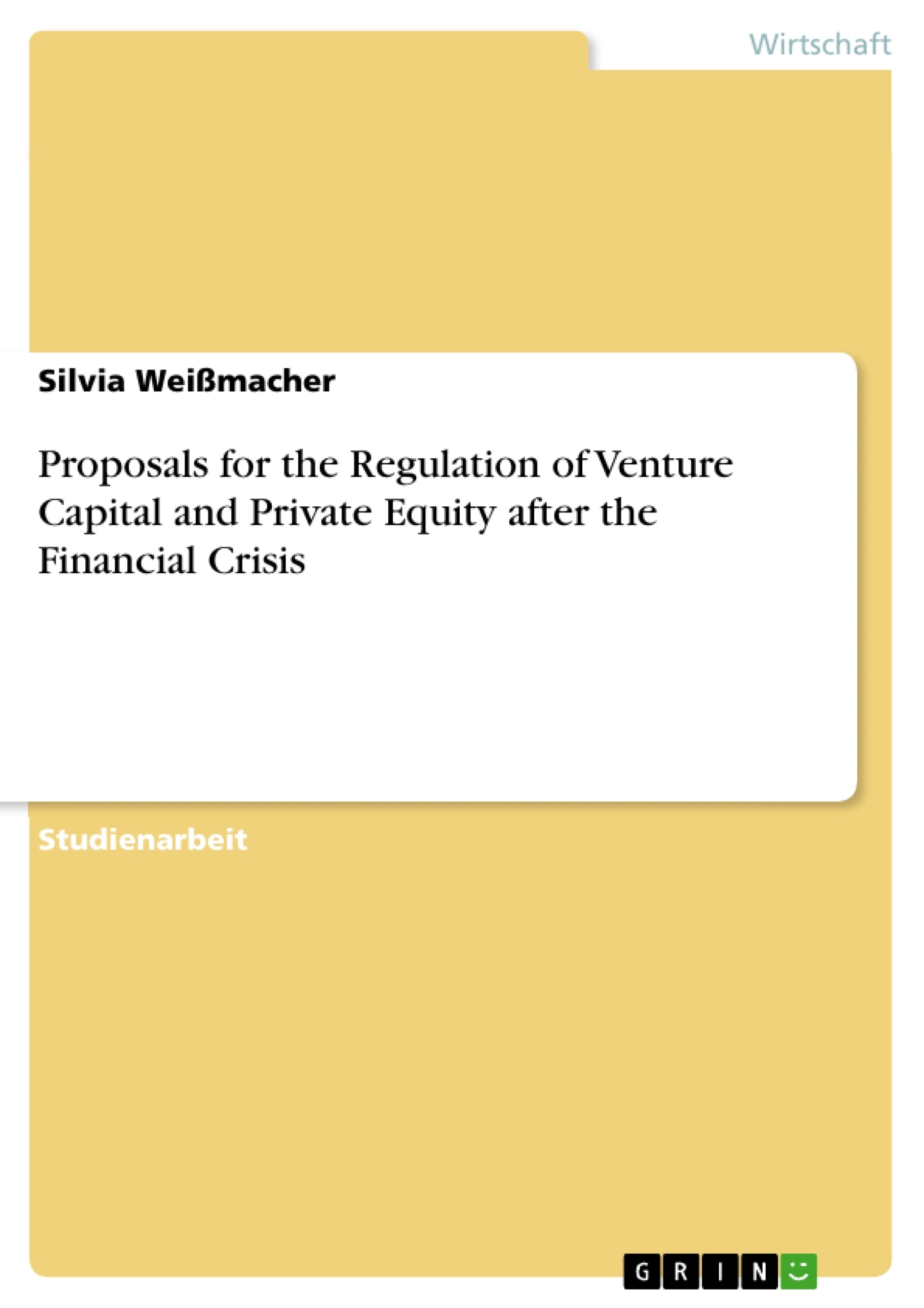In this seminar paper, I demonstrate and evaluate proposals for the regulation of VC and PE including HF in Germany, Europe and the United States (US) after the global financial crisis. In the first chapter of the main part, I describe the impacts of the financial crisis on PE and VC. In the second part, a short overview of the present regulatory framework in Germany, Europe and the United States is presented. The core of this seminar paper will be chapter 4, 5 and 6 in which proposals and its assessment for a regulation of PE and VC after the financial crisis are exposed, especially the so-called Alternative Investment Fund ManagerDirective (AIFMD), an European initiative to regulate fund manger’s activities. Further, the estimation of the AIFMD by the European PE and VC Association (EVCA), the “Bundesverband Deutscher Kapitalbeteiligungsgesellschaften (BVK)” and the international press will offer an all-embracing appraisal. With an executive summary, I conclude my seminar paper.
Inhaltsverzeichnis
- 1.0 Introduction
- 2.0 Impacts of the Global Financial Crisis on Private Equity and Venture Capital
- 3.0 Overview of the Present Regulatory Activity
- 3.1 Germany
- 3.1.1 The „Unternehmensbeteiligungsgesellschaft (UBG)“
- 3.1.2 The Capital Investment Company and the „Investmentaktien-gesellschaft nach dem Investmentgesetz (InvG)\"
- 3.2 Europe
- 3.2.1 The Markets in Financial Instruments Directive (MiFID)
- 3.2.2 The Alternative Investment Fund Managers Directive (AIFMD)
- 3.3 United States
- 3.3.1 The Investment Company Act (ICA)
- 3.3.2 The Investment Advisors Act (IAA) and the Securities and Exchange Commission (SEC)
- 3.3.3 The Securities Act and the Securities Exchange Act
- 3.3.4 The Dodd-Frank Wall Street Reform
- 3.1 Germany
- 4.0 Proposals for the Regulation of Private Equity and Venture Capital after the Financial Crisis
- 4.1 Germany
- 4.1.1 Regulatory Interest Groups
- 4.1.2 Regulatory Framework
- 4.2 Europe
- 4.2.1 Regulatory Interest Groups
- 4.2.2 Regulatory Framework: The AIFM Directive
- 4.2.2.1 Oversight and Control
- 4.2.2.2 Operating Conditions
- 4.2.2.3 Disclosure to Regulators
- 4.3 United States
- 4.3.1 Regulatory Interest Groups
- 4.3.2 Regulatory Framework
- 4.3.2.1 Establishment of a Systemic Risk Regulator
- 4.3.2.2 Interdiction of Investment in PE Funds by Banks
- 4.3.2.3 Taxation of Private Equity Firms
- 4.1 Germany
- 5.0 Estimation of the Alternative Investment Fund Management Directive by the European Private Equity and Venture Capital Association (EVCA), the “Bundesverband Deutscher Kapital-beteiligungsgesellschaften (BVK)\" and the International Press
- 6.0 Evaluation and Assessment
- 6.1 Evaluation of Present Regulation
- 6.1.1 Germany: The “Unternehmensbeteiligungsgesellschaft (UBG)\" and the \"Investmentgesellschaft nach dem Investmentgesetz (InvG)\"
- 6.1.2 Europe: The Markets in Financial Instruments Directive (MiFID)
- 6.1.3 United States: The Frank-Dodd Wall Street Reform
- 6.2 Evaluation of Proposed Options
- 6.2.1 Germany: Self-Regulation, Skill-enhancement, Acting in Concert and the \"Risikobegrenzungsgesetz\"
- 6.2.2 Europe: The AIFM Directive
- 6.2.3 United States: Skill-Enhancement, Protective Mechanisms, the Financial Services Oversight Council, Interdiction of Investment in PE Funds by Banks, Taxation and the Regulation of Banks
- 6.1 Evaluation of Present Regulation
Zielsetzung und Themenschwerpunkte
Diese Seminararbeit analysiert die Auswirkungen der globalen Finanzkrise auf die Private Equity- und Venture Capital-Branche. Die Arbeit untersucht die Regulierungsaktivitäten in Deutschland, Europa und den Vereinigten Staaten und analysiert die verschiedenen Vorschläge für eine Regulierung von Private Equity und Venture Capital nach der Finanzkrise. Die Arbeit konzentriert sich auf die Bewertung und Beurteilung der vorgeschlagenen Regulierungsmaßnahmen und deren Auswirkungen auf die Branche.
- Auswirkungen der Finanzkrise auf Private Equity und Venture Capital
- Regulierungslandschaft in Deutschland, Europa und den Vereinigten Staaten
- Bewertung und Beurteilung der vorgeschlagenen Regulierungsmaßnahmen
- Potentielle Auswirkungen der Regulierung auf die Branche
- Analyse der verschiedenen Interessengruppen in der Regulierungsdebatte
Zusammenfassung der Kapitel
- Kapitel 1.0: Introduction: Diese Einleitung bietet einen Überblick über die Thematik der Arbeit und die Relevanz der Regulierung von Private Equity und Venture Capital.
- Kapitel 2.0: Impacts of the Global Financial Crisis on Private Equity and Venture Capital: Dieses Kapitel analysiert die Auswirkungen der globalen Finanzkrise auf die Private Equity- und Venture Capital-Branche und beleuchtet die verschiedenen Herausforderungen, die diese Branche im Zuge der Finanzkrise bewältigen musste.
- Kapitel 3.0: Overview of the Present Regulatory Activity: Dieses Kapitel bietet einen umfassenden Überblick über die derzeitige Regulierungslandschaft für Private Equity und Venture Capital in Deutschland, Europa und den Vereinigten Staaten. Es analysiert die wichtigsten Regulierungsmaßnahmen und deren Auswirkungen auf die Branche.
- Kapitel 4.0: Proposals for the Regulation of Private Equity and Venture Capital after the Financial Crisis: Dieses Kapitel untersucht die verschiedenen Vorschläge für eine Regulierung von Private Equity und Venture Capital nach der Finanzkrise. Es analysiert die Interessen der verschiedenen Stakeholder und die vorgeschlagenen Regulierungsmaßnahmen.
- Kapitel 5.0: Estimation of the Alternative Investment Fund Management Directive by the European Private Equity and Venture Capital Association (EVCA), the “Bundesverband Deutscher Kapital-beteiligungsgesellschaften (BVK)\" and the International Press: Dieses Kapitel analysiert die Reaktion auf die vorgeschlagene Alternative Investment Fund Management Directive (AIFMD) durch verschiedene Interessengruppen wie die EVCA, den BVK und die internationale Presse.
- Kapitel 6.0: Evaluation and Assessment: Dieses Kapitel bewertet und beurteilt die vorgeschlagenen Regulierungsmaßnahmen. Es analysiert die Stärken und Schwächen der verschiedenen Vorschläge und untersucht die potenziellen Auswirkungen der Regulierung auf die Branche.
Schlüsselwörter
Die wichtigsten Schlüsselwörter und Schwerpunktthemen dieser Seminararbeit sind: Private Equity, Venture Capital, Finanzkrise, Regulierung, AIFMD, MiFID, UBG, Investmentaktien-gesellschaft, Dodd-Frank Wall Street Reform, Interessengruppen, Bewertung, Beurteilung, Auswirkungen, Regulierungslandschaft.
- Quote paper
- Silvia Weißmacher (Author), 2010, Proposals for the Regulation of Venture Capital and Private Equity after the Financial Crisis, Munich, GRIN Verlag, https://www.grin.com/document/187151



